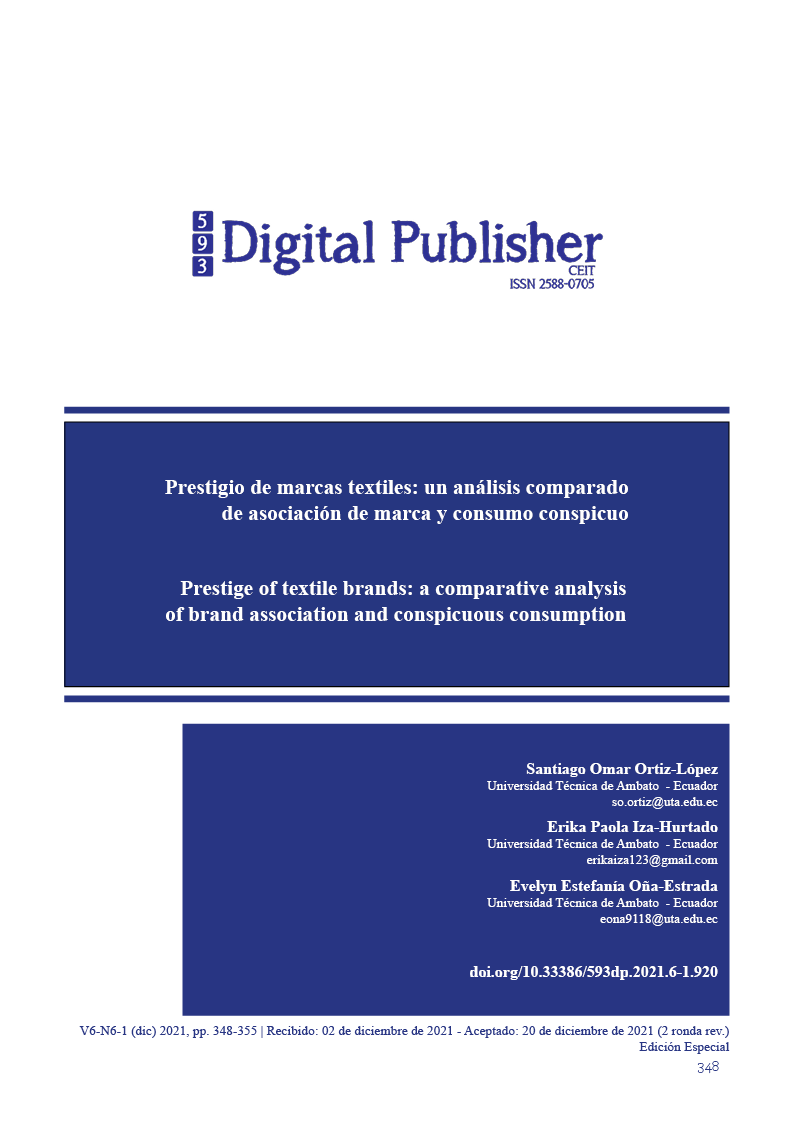Prestige of textile brands: a comparative analysis of brand association and conspicuous consumption
Main Article Content
Abstract
The problem evidenced in the textile market is that consumers are attracted to luxury items (positioned brands), mainly because of the social value and symbolism associated with the brand. In this sense, consumers strive to improve their social position by engaging in conspicuous consumption to improve or exaggerate their social position in society. The objective of the work is to analyze the relationship between social class and the conspicuous consumption trend to determine the effect of the brand association according to the correlational scope. The method used was Sprott's which evaluated the brand association. The study sample was from the province of Tungurahua at the age of 26.7 years. The perception of it was tested according to the textile products of the brands RM, Etafashion, Aeropostale. The findings showed that individuals from higher social classes are more likely to engage in discrete consumption, while the middle class prefers more conspicuous (luxurious) consumption. It is concluded that the letter provides information on the motivations of consumers that lead to a luxury badge.
Downloads
Article Details

This work is licensed under a Creative Commons Attribution-NonCommercial-ShareAlike 4.0 International License.
1. Derechos de autor
Las obras que se publican en 593 Digital Publisher CEIT están sujetas a los siguientes términos:
1.1. 593 Digital Publisher CEIT, conserva los derechos patrimoniales (copyright) de las obras publicadas, favorece y permite la reutilización de las mismas bajo la licencia Licencia Creative Commons 4.0 de Reconocimiento-NoComercial-CompartirIgual 4.0, por lo cual se pueden copiar, usar, difundir, transmitir y exponer públicamente, siempre que:
1.1.a. Se cite la autoría y fuente original de su publicación (revista, editorial, URL).
1.1.b. No se usen para fines comerciales u onerosos.
1.1.c. Se mencione la existencia y especificaciones de esta licencia de uso.
References
Angle, J.W. and Forehand, M.R. (2016), “It’s not us, it’s you: how threatening self-brand association leads to brand pursuit”, International Journal of Research in Marketing, Vol. 33 No. 1, pp. 183-197.
Adler, N.E. and Snibbe, A.C. (2003), “The role of psychosocial processes in explaining the gradient between socioeconomic status and health”, Current Directions in Psychological Science, Vol. 12 No. 4, pp. 119-123.
Belk, R.W., Bahn, K.D. and Mayer, R.N. (1982), “Developmental recognition of consumption symbolism”, Journal of Consumer Research, Vol. 9 No. 1, pp. 4-17.
Berg, J.M., Wrzesniewski, A. and Dutton, J.E. (2010), “Perceiving and responding to challenges in job crafting at different ranks: when proactivity requires adaptivity”, Journal of Organizational Behavior, Vol. 31 Nos 2‐3, pp. 158-186.
Berger, J. and Ward, M. (2010), “Subtle signals of inconspicuous consumption”, Journal of Consumer Research, Vol. 37 No. 4, pp. 555-569.
Bourdieu, P. (1987), “What makes a social class? On the theoretical and practical existence of groups”, Berkeley Journal of Sociology, Vol. 32, pp. 1-17.
Côté, S. (2011), “How social class shapes thoughts and actions in organizations”, Research in Organizational Behavior, Vol. 31 No. 2, pp. 43-71.
Duan, J. and Dholakia, N. (2015), “The reshaping of Chinese consumer values in the social media era: exploring the impact of Weibo”, Qualitative Market Research: An International Journal, Vol. 18 No. 4, pp. 409-426.
Eckhardt, G.M., Belk, R.W. and Wilson, J.A. (2015), “The rise of inconspicuous consumption”, Journal of Marketing Management, Vol. 31 Nos 7-8, pp. 807-826.
Ferraro, R., Kirmani, A. and Matherly, T. (2013), “Look at me! Look at me! Conspicuous brand usage, self- brand connection, and dilution”, Journal of Marketing Research, Vol. 50 No. 4, pp. 477-488.
Kastanakis, M.N. and Balabanis, G. (2014), “Explaining variation in conspicuous luxury consumption: an individual differences’ perspective”, Journal of Business Research, Vol. 67 No. 10, pp. 2147-2154.
Ko, E., Costello, J.P. and Taylor, C.R. (2017), “What is a luxury brand? A new definition and review of the literature”, Journal of Business Research, Vol. 99, pp. 405-413.
Kraus, M.W., Piff, P.K. and Keltner, D. (2009), “Social class, sense of control, and social explanation”,Journal of Personality and Social Psychology, Vol. 97 No. 6, pp. 992-1004.
Kraus, M.W., Piff, P.K., Mendoza-Denton, R., Rheinschmidt, M.L. and Keltner, D. (2012), “Social class, solipsism, and contextualism: how the rich are different from the poor”, Psychological Review, Vol. 119 No. 3, pp. 546-572.
Richins, M.L. (1994), “Special possessions and the expression of material values”, Journal of Consumer Research, Vol. 21 No. 3, pp. 522-533.
Rovai, S. (2014), “The evolution of luxury consumption in China”, in Atwal, G. and Bryson, D. (Eds), Luxury Brands in Emerging Markets, Palgrave Macmillan, London, pp. 130-134.
Shukla, P., Singh, J. and Banerjee, M. (2015), “They are not all same: variations in Asian consumers’ value perceptions of luxury brands”, Marketing Letters, Vol. 26 No. 3, pp. 265-278.
Oakes, J.M. and Rossi, P.H. (2003), “The measurement of SES in health research: current practice and steps toward a new approach”, Social Science & Medicine, Vol. 56 No. 4, p 769-784.
Wilcox, K., Kim, H.M. and Sen, S. (2009), “Why do consumers buy counterfeit luxury brands?”, Journal of Marketing Research, Vol. 46 No. 2, pp. 247-259.




